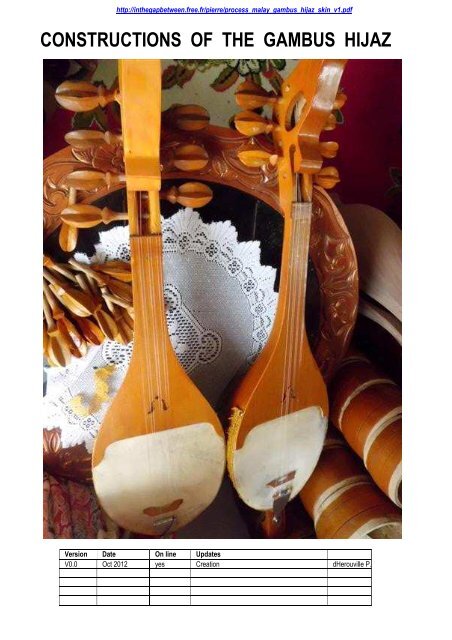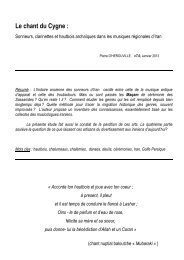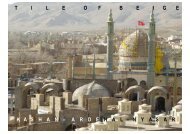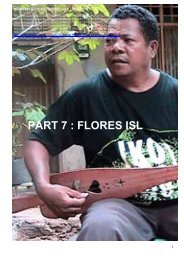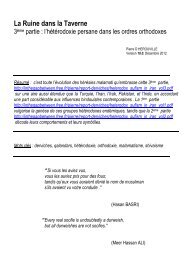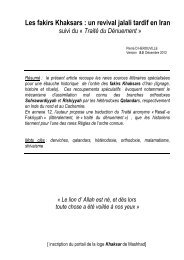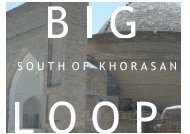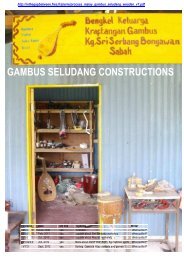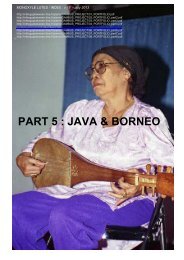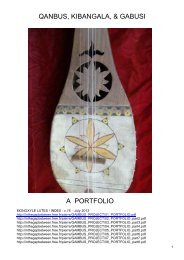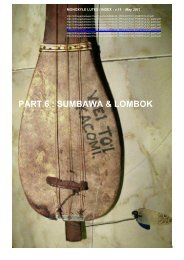process_malay_gambus.. - In the gap between - Free
process_malay_gambus.. - In the gap between - Free
process_malay_gambus.. - In the gap between - Free
You also want an ePaper? Increase the reach of your titles
YUMPU automatically turns print PDFs into web optimized ePapers that Google loves.
http://in<strong>the</strong><strong>gap</strong><strong>between</strong>.free.fr/pierre/<strong>process</strong>_<strong>malay</strong>_<strong>gambus</strong>_hijaz_skin_v1.pdf<br />
CONSTRUCTIONS OF THE GAMBUS HIJAZ<br />
Version Date On line Updates<br />
V0.0 Oct 2012 yes Creation dHerouville P.
Exhibition of Gambus lutes of <strong>the</strong> natives in NTB museum, Nusa Tenggar Barat, Sunda.<br />
The Gambus name nowadays took an unexplicit acception in <strong>the</strong> indonesian archipelago, since <strong>the</strong> word<br />
became synonymous of “middle east-like lute” <strong>the</strong>re. If <strong>the</strong> word is certainly rooted in <strong>the</strong> Yemeni name “Qanbus”,<br />
according to <strong>the</strong> homonymous lute of <strong>the</strong> Sana’an plateau, for sure, every current <strong>In</strong>donesian avatars now embody<br />
various designs. Three main categories of Gambus coexist Malaysia and <strong>In</strong>donesia:<br />
1. - Gambus Hijaz, a monoxyle, long necked lute. Also known <strong>the</strong>re as Gambus Melayu (<strong>malay</strong>, incl. Kutai<br />
tribesmen in south Kalimantan), Panting (Benjmarsin/Banjarmasin, and, actually everywhere in Kalimantan)<br />
, Gita Nangka (Sin<strong>gap</strong>ore), Gambus Seludang , Gambus Perahu , Gambus Biawak , Gambus<br />
Palembang The instrument is now rare and hardly survives reportedly in Johor state, Sarawak (near<br />
Kuching), Sabah (Semporna, and seldom in Papar, Bongawan), Kalimantan (panting music in Benjmarsin<br />
/Banjarmasin) and various districts of Sumatra districts : Bengkalis, Penyengat, Jambi, & Medan.<br />
Considering its extinction in Malacca and Johore, such shape of Gambus was significantly preserved,<br />
indeed:<br />
-- in Borneo (Kalimantan, Brunei, Sarawak and Sabah)<br />
-- in Eastern Sumatra (Bangka isl, Kayu Agung, Lampung)<br />
- in West Sumatra (mostly Medan: province of Aceh)<br />
-- in <strong>the</strong> path of Malacca (Penyagat, Riau)<br />
<strong>In</strong>deed, some few alternate skin-boarded, “Gambus” named, avatars are also still observable as far<br />
as Makassar (Sulawezi), Brunei, Moluccas, East Kalimantan, and Nusa Tengarra Barat. But that design is<br />
clearly under extinction all over<strong>the</strong>re, or substituted by alternate, wooden covered designs.
GAMBUS– MONOXYLE LUTES, BEAUFORT, SABAH (BORNEO)<br />
Thin shaped Gambus Biawak lute (Beaufort, Sabah). Outlet are drilled in <strong>the</strong> soundboard.<br />
GAMBUS– MONOXYLE LUTES, MAKASSAR (SULAWEZI)<br />
That typical sulawenese design is actually inspired by <strong>the</strong> shape of tribal lute: <strong>the</strong> Kecapi.
GAMBUS– MONOXYLE LUTES, TEGGENRUNG, EAST KALIMANTAN<br />
Thin shaped Panting lute (Teggenrung, eastern Kalimantan). Outlet are drilled in <strong>the</strong><br />
soundboard. The material of <strong>the</strong> soundboard might be a fabric.<br />
GAMBUS – MONOXYLE LUTES, MAKASSAR (SULAWEZI)<br />
Gambus lute of <strong>the</strong> folklorical troupe Kobi Tallua (Makasar, SW Sulawezi). The<br />
closed design of <strong>the</strong> pegbox is widespread <strong>the</strong>re.
Now on <strong>the</strong> way to extinction in many places, <strong>the</strong> Gambus Hijaz lute is still (seldom) accompanying<br />
Zapin / Jepen dance (Ar. Zafin, a dance genre from Hadhramawt, still widespread in Sawt-like sessions in<br />
<strong>the</strong> Gulf countries) namely <strong>the</strong> local Hamdolok dance – Batu Pahat – and <strong>the</strong> Zapin Banjar - Kalimantan-.<br />
Considering that Johore’s Ghazal music now substituted Gambus Hijaz lute with oud in continental<br />
Malaysia, <strong>the</strong> relevant regional musical avatars for Zafin & Gambus Hijaz are nowadays Hamdolok (Batu<br />
Pahat), Tingkilan (Kutai tribesmen, south Kalimantan) and Panting-Banjar ( south Kalimantan and<br />
surroundings of Benjmarsin/Banjarmasin city). The name Banjar echoes obviously “Banjarmasin”, which is<br />
an harbor-city, situated south of Kalimantan.<br />
<strong>In</strong> Kalimantan, strings of <strong>the</strong> Panting lute used to be made of twisted vegetal fibers (haduk hanau (<br />
ijuk ) nenas, bikat, bast or twisted sinali), but nylon strings are now in use. The quantity of string rose from 3 ,<br />
up to 10. Each string of <strong>the</strong> Panting is reported as a part of 3 choirs, namely:<br />
1. Pangalik: first string/choir, ringing <strong>the</strong> penyisip a.k.a melody.<br />
2. Panggundah or Pangguda second string/choir, a.k.a. constituent indones. paningkah.<br />
3. Agur, that is played as a bass string, or buzz.<br />
The formalization of <strong>the</strong> Panting-Banjar genre doesn’t date back later than <strong>the</strong> mid 1970’s, since this<br />
genre possibly merged actually various remnant reliefs of former foklores. Actually it used reportedly to<br />
accompany Gandut dance and Zapin. A former musical forecomer was <strong>the</strong> Kasenian Bajapin, whose<br />
original line up (1973) was 1 Gambus melayu/ Gambus Hadramawt lute, 1 Babun percussion, 1 gong.<br />
Violin is reported to have substituted <strong>the</strong> former Triangle idiophon. Now <strong>the</strong> usual line up features alternately<br />
2 Gambus melayu/ Gambus Hadramawt lutes , 1 locally made Cello, or, alternately, 1 rebana viele, 1<br />
marwas –like drum, and some additional mandolinas, or 1 Panting ( a.k.a. Gambus melayu/ Gambus<br />
Hadramawt ), 1 violin, 1 Kendang framedrum. From 1979, one can observe additional talinting and giring<br />
giring musical instruments, <strong>the</strong>n sound systems. <strong>In</strong> 1977, <strong>the</strong> vocal repertoire is reported to have been<br />
infected by Banjar language sung songs. <strong>In</strong> <strong>the</strong> early 1980’s it has grown up as an identitary genre and<br />
every district in Kalimantan now have an official ensemble at least. The proper variant of <strong>the</strong> Zapin dance for<br />
Panting Banjar in Kalimantan is named Zapin Sigam.<br />
The Tingkilan/ Betingkilan genre is <strong>the</strong> exclusive chamber music among <strong>the</strong> Kutai people<br />
(Kalimantan) Now <strong>the</strong> usual line up features alternately 2 Gambus melayu/ Gambus Hadramawt lutes with<br />
1 locally made Cello, or, alternately, 1 rebana viele, 1 marwas –like drum, and some additional mandolinas.<br />
The instrumental music is named Tingkilan, and its vocal variant is named Betingkilan. This chamber music<br />
accompanies <strong>the</strong> Zapin dances for occasions, such as weddings, one performs such Tingkilan and Zapin<br />
dance. It seems that <strong>the</strong> genre is actually typical of <strong>the</strong> Kutai tribesmen of <strong>the</strong> Kalimantan.<br />
2 - Gambus Hadramawt, an oud-like lute. We describe <strong>the</strong> relevant <strong>process</strong> in <strong>the</strong> document named<br />
“<strong>process</strong>_<strong>malay</strong>_<strong>gambus</strong>_Vx.pdf” .The instrument features <strong>the</strong> conventional glued ribs, or « arched back »<br />
technics, as HILARIAN use to name it. This is famous in peninsular Malaysia as <strong>the</strong> « Gambus Johor », as<br />
this is appreciated <strong>the</strong>re still when performing local avatars of <strong>the</strong> Ghazal musical performance. This can be<br />
found still in Johor state, Brunei, Sabah, Java , Sumatra, Madura, Sulu. The instrument is still much<br />
appreciated in Brunei, where this was presumately introduced <strong>the</strong>re much later than <strong>the</strong> Gambus Hijaz. It<br />
seems this is revived <strong>the</strong>re, and still constructed according egyptian design pattern,mostly for Zapin and<br />
Qasida accompaniement.<br />
3- Bruneian monoxyle Gambus Seludang is a local crossover design family in Brunei and Sabah. This<br />
name « Seludang » is reported by HILARIAN as a former vernacular nickname of <strong>the</strong> Gambus Hijaz , but<br />
<strong>the</strong> bruneian making technics and organology – obvious specific feature is a 100% wooden soundboard -<br />
differentiates it apart both existing Gambus Hijaz and Gambus Hadramawt families. We describe <strong>the</strong><br />
relevant <strong>process</strong> in <strong>the</strong> document named “<strong>process</strong>_<strong>malay</strong>_<strong>gambus</strong>_Vx.pdf<br />
HILARIAN claims <strong>the</strong> name « Seludang » to root from <strong>the</strong> shape of a local palm sheath, and this may<br />
differentiate it in <strong>the</strong> local vernacular vocabulary of Sabah, as Gambus Hijaz was basically nicknamed<br />
Gambus Biawak in this far territory, as HILARIAN says. Actually, <strong>the</strong> confusing « Seludang » name<br />
presumately suggests this endemic monoxyle construction may have originated in latter evolutions of local<br />
technics, after <strong>the</strong> oud to have been reintroduced in Brunei. The local cause of this change may be <strong>the</strong><br />
outstanding profusion of abunding huge jack trees and teack trees in Brunei, Sarawak and Sabah.
Recent rise of this Gambus construction in Papar and Bongawan, let us focus upon <strong>the</strong> wide range of somade<br />
lutes :<br />
3.1- Saludang Mayang are narrow boxed instruments, much similar as <strong>the</strong> Gambus Hijaz - i.e.<br />
shape and size- , but <strong>the</strong> soundbard is made of wood indeed.<br />
3.2- Saludang Buntal are wider shaped lutes, whose soundox width varies from <strong>the</strong> Mayang’s one<br />
(about 25 cm) up tu a conventional oud’s one. <strong>In</strong> this category both monoxyle construction and 0.80<br />
down-scaled conventional oud lutes, as <strong>the</strong> « «arched back » construction technics survives in Brunei<br />
and Papar, Sabah. Organology speaking, Gambusu lutes from Sunda and Sulawezi are globally very,<br />
very similar. Some feature 4 choirs, some feature 5.<br />
3.3- Gambus Kecil are <strong>the</strong> smallest monoxyle <strong>gambus</strong> in Brunei, much shorter than Saludang<br />
Mayang. As large as a ukulele.<br />
These bruneian monoxyle lutes are being revived in <strong>the</strong> area of Papar, where <strong>the</strong>y are in use for a Zapin<br />
music annual festival.. According to Larry Francis HILARIAN, this is very same as <strong>the</strong> Gambusu design in<br />
Sulawesi.<br />
This document summarizes endemic construction techniques , mostly for <strong>the</strong> skin-boarded Gambus Hijaz lute of<br />
Malaysia, namely Gambus Melayu, Panting or Gambus Seludang of Malaysia.<br />
About wood-boarded Gambus lute making, see alternate file<br />
http://in<strong>the</strong><strong>gap</strong><strong>between</strong>.free.fr/pierre/<strong>process</strong>_<strong>malay</strong>_<strong>gambus</strong>_seludang_wooden_v7.pdf
4.<br />
3.<br />
MALAYSIAN GAMBUS - TYPOLOGY<br />
PRODUCTION BY MAKER « PAK MAT », KAMPUNG RAHMAT, BATU PAHAT, JOHOR<br />
1. Gambus Melayu, Batu Pahat 2. Gambus Hadramawt, Batu Pahat<br />
3. Gambus Hadramawt, Batu Pahat, Johor 4. Gambus a.k.a. Saludang Buntal (Borneo design)<br />
1.<br />
2.
MALAYSIAN GAMBUS - TYPOLOGY<br />
1. 2. 3. 4. 5. 6.<br />
1. Gambus Melayu, Bengkalis , 2. Gambus Melayu, Sumatra<br />
3. Gambus Melayu, Batu Pahat, Johor, 4. Gambus Melayu , Brunei<br />
5. Gambus a.k.a. Saludang Buntal, Brunei & Sabah 6. Gambus Kecil, Brunei<br />
We can observe below, that <strong>the</strong> bulky design (items 1 & 3) is typical for Riau archipelago, if we<br />
consider <strong>the</strong> shape nr 4 as latest visible variant in Johore state. (Data by Larry Francis<br />
HILARIAN)
GAMBUS HIJAZ - ORGANOLOGY – VERNACULAR NAMES (JOHOR, MALAYSIA)<br />
Malay name of <strong>the</strong> components , drawing and data from Larry Francis HILARIAN
GAMBUS - ORGANOLOGY – VERNACULAR NAMES (SIAK, RIAU, SUMATRA)<br />
Endemic names of <strong>the</strong> components of <strong>the</strong> Gambus Seludang “Bedeleau” lute,<br />
according to <strong>the</strong> variant of Siak, Riau province in Sumatra. Drawing and data by maker<br />
Tengku FIRDAUS. Features are <strong>the</strong> lates known standards by this maker. Neck is sedom<br />
partially hollowed, o<strong>the</strong>rwise not.
DAMBUS - ORGANOLOGY – VERNACULAR NAMES (BANGKA ISL, SUMATRA)<br />
Endemic names of <strong>the</strong> components of <strong>the</strong> Dambus lute, according to a so-called<br />
wooden-soundboarded variant of Bangka Island, S-East Sumatra. Drawing and data by<br />
maker KUSUKENI.
GAMBUS CRAFT SHOP (SIAK, RIAU)<br />
Monoxyle Gambus Melayu lutes, smaller sizes by maker Tengku FIRDAUS (Siak , Riau province). Here <strong>the</strong> design<br />
dating <strong>the</strong> era 2006-2012.
GAMBUS SELUNDANG (PAPAR, SABAH) – MAKER’S WORKSHOP<br />
Maker Awang Pesa ris letting drying cattle skins. This means that bruneian maker may make as well some<br />
few Gambus Melayu-like so called Gambus Hijaz, or Tari –like frame drums. Maker Awang PESAR, Seri<br />
Serbang, Bongawan, Sabah.<br />
(photo Melissa WONG webblog)<br />
GAMBUS SELUDANG “ BEDELEAU” (SIAK, RIAU) – MAKER’S WORKSHOP
GAMBUS HIJAZ (LABUAN, BORNEO) – BODY CARVING<br />
Hajj Ishak MANSUR (Banjo Labuan, Borneo, <strong>In</strong>donesia)<br />
(photo unknown web source)
GAMBUS SELUDANG “ BEDELEAU” (SIAK, RIAU) – CARVING BODY & SOUNDBOX<br />
Maker Tengku FIRDAUS while carving out <strong>the</strong> body of a Gambus Seludang “Bedeleau”<br />
(photo TLukman Hakim)<br />
Maker Tengku FIRDAUS while carving <strong>the</strong> body of a Gambus Seludang “Bedeleau” out of a jack<br />
tree wood. The fact that this maker never carves longer more than 20 cm inside <strong>the</strong> neck is a<br />
noticeable fact. (photo TLukman Hakim)
GAMBUS “ MISRI” (TANJUNG MORAWA, MEDAN, SUMATRA )– CARVING SOUNDBOX<br />
Carving Gambus Mirsi soundbox in plain wood by gouge.<br />
(photo weblog Kampung Halaman, 2000’s)<br />
This anonymous maker is carving Gambus Mirsi lutes according <strong>the</strong> Medanese criteria: bulky<br />
soundbox, closed pegbox and thin, long neck (photo weblog Kampung Halaman, 2000’s)
GAMBUS “ MISRI” (TANJUNG MORAWA, MEDAN, SUMATRA )– CARVING SOUNDBOX<br />
Carving Gambus Mirsi soundbox in plain wood by gouge.<br />
(photo weblog Kampung Halaman, 2000’s)
GAMBUS SELUDANG “ BEDELEAU” (SIAK, RIAU) – CARVING SOUNBOXES<br />
Carving out <strong>the</strong> body of a Gambus Seludang “Bedeleau” lute. Maker Tengku FIRDAUS in Kabupaten Siak,<br />
Riau province, Sumatra (picture by web source Bedeleau.com)
GAMBUS HIJAZ (BATU PAHAT) – CARVING SOUNDBOXES<br />
Carved body in Batu Pahat, Johore state. Notice <strong>the</strong> lateral groove carving , so that <strong>the</strong><br />
fingerboard to be inserted inside <strong>the</strong> body. Maker Hasan Bin OTHMAN , Kampung Parit Hailam,<br />
Batu Pahat, Johore state.<br />
GAMBUS HIJAZ (BATU PAHAT) – CARVING SOUNBOXES<br />
Carved body . According to HILARIAN, usual woods for this are nangka (jack tree),<br />
Chempedak, and Cengal , as <strong>the</strong>y notoriously don’t shrink when carved.
GAMBUS SELUDANG “ BEDELEAU” (SIAK, RIAU) – POLISHING THE SOUNDBOX<br />
Maker Tengku FIRDAUS while polishing a Gambus Seludang “Bedeleau” body. (photo TLukmanHakim)
GAMBUS SELUDANG “ BEDELEAU” (SIAK, RIAU) –SKIN PEELING<br />
Skin <strong>process</strong>ing is generally <strong>the</strong> less known <strong>process</strong>us of <strong>the</strong> lute maker. Maker FIRDAUS<br />
(Riau) is peeling every goat skin hair. (picture by T Lukman HAKIM)<br />
GAMBUS HIJAZ – COVERING BY SKIN<br />
Maker FIRDAUS (Riau) is drawing on <strong>the</strong> back of <strong>the</strong> ready skin. (T Lukman HAKIM)
GAMBUS SELUDANG “ BEDELEAU” (SIAK, RIAU) – STRETCHING THE SKIN<br />
After nailing one side of <strong>the</strong> skin, <strong>the</strong> maker is stretching <strong>the</strong> skin with a clamp (T Lukman HAKIM)<br />
GAMBUS HIJAZ – COVERING BY SKIN<br />
The skin is fixed and tight on <strong>the</strong> soundbox. Here an unorthodox stringholder from Medan ,<br />
Sumatra (courtesy of Larry Francis HILARIAN)
GAMBUS SELUDANG “ BEDELEAU” (SIAK, RIAU) -ADJUSTING SOUNDBOARD<br />
The finition of <strong>the</strong> Gambus Seludang “Bedeleau” lute: <strong>the</strong> soundboard is made of a goat skin. This design of<br />
Riau includes tiny, wooden side-covers. Made by maker Tengku FIRDAUS, workshop BEDELEAU (Siak Isl,<br />
Riau, Malacca straits). Here <strong>the</strong> soundboard design dating year 2012. (picture by web source Bedeleau.com)
GAMBUS HIJAZ – ADJUSTING SOUNDBOARD WITH FINGERBOARD<br />
Fingerboard is accommodated so that <strong>the</strong> thick goat skin cover to be glued properly . Gambus Hijaz<br />
from Penyengat isl, Riau Archipelago, <strong>In</strong>donesia. (courtesy of Larry Francis HILARIAN)<br />
GAMBUS HIJAZ (GEYLANG, SINGAPORE) – CARVED SOUNDHOLE IN FINGERBOARD<br />
The rose was carved by <strong>the</strong> craftsman down to <strong>the</strong> fingerboard (Geylang Museum, Sin<strong>gap</strong>ore)
GAMBUS SELUDANG “KLASSIK” (RIAU) – “SUN” SHAPED SOUNDHOLES<br />
Early production (2002-2006) of <strong>the</strong> skin boarded Gambus Seludang by Tengku<br />
FIRDAUS, features sun-shaped ( indones. Matahari), referring to former traditional<br />
designs. Then it changed to Ylang flower shape. Maker Tengku FIRDAUS, Siak, Riau<br />
province, Sumatra. (photo Bedeleau.com )<br />
GAMBUS SELUDANG “BEDELAU” (RIAU) – “YLANG” FLOWER SHAPED SOUNDHOLE<br />
Ylang flower-shaped soundholes are typical of <strong>the</strong> late production of <strong>the</strong> skin boarded<br />
Gambus Seludang “Bedeleau” by Tengku FIRDAUS, <strong>between</strong> 2006 and til after 2012..<br />
Maker Tengku FIRDAUS, Siak, Riau province, Sumatra. (photo Bedeleau.com )
GAMBUS HIJAZ (BATU PAHAT) – SOUNDBOARD COVER<br />
This huge soundboard is specific of a large size descent of loud Gambus Hijaz in Batu Pahat, Johor state,<br />
where this has been played in Hamdolok religious performance until recently. This item by maker Hasan BIN<br />
OTHMAN is held now by Larry Francis HILARIAN (courtesy of Larry Francis HILARIAN).
GAMBUS MELAYU SELUDANG “ BEDELEAU” (SIAK, RIAU) – FINITION<br />
The finition of <strong>the</strong> Gambus Seludang “Bedeleau” lute: <strong>the</strong> soundboard is made of a large board. Made by<br />
maker Tengku FIRDAUS, workshop BEDELEAU (Siak Isl, Riau, Malacca straits). Here <strong>the</strong> soundboard design<br />
dating year 2012. (picture by web source Bedeleau.com)
GAMBUS MELAYU / HIJAZ – SHAPING THE PEGBOX<br />
Pegbox (indones. Kepala, or head) of a Gambus Melayu from<br />
Bengkalis Isl , Riau Province (LF HILARIAN collection ). The<br />
<strong>In</strong>donesian name for pegs is Telinga (indones. Ears)<br />
Pegbox of a small a Gambus Melayu by Hasan Bin Osman,<br />
Batu Pahat, Johore<br />
Modern pegbox of a Gambus Melayu by maker Tengku FIRDAUS,<br />
(Siak, Riau, web source Bedeleau.com, 2012). Pegbox shape is<br />
named Naga Menganga (indones. wide open dragon head) in Riau.<br />
FIRDAUS adopted Tematu peg shape for his latest production,<br />
namely Gambus Seludang Bedeleau (2006-2012…).<br />
Pegbox of a Gambus Melayu from Bengkalis Isl , Riau Province<br />
(courtesy of Larry Francis HILARIAN. ). This traditional shape of<br />
pegs is named Tematu (indones. palm tree fruit)
GAMBUS SELUDANG “ BEDELEAU” (SIAK, RIAU) – CARVING PEGS<br />
This shape of pegs is named Tematu ( indones. palm fruit) - picture by T Lukman HAKIM)<br />
GAMBUS SELUDANG “ BEDELEAU” (SIAK, RIAU) – DRILLING PEGS<br />
This shape of pegs is named Tamura ( indones. palm fruit) ( picture T Lukman HAKIM)
GAMBUS HIJAZ – HOLDING THE STRINGS<br />
String Holder of <strong>the</strong> Gambus Melayu (Seludang) lute, unknown location in <strong>In</strong>donesia. The shape of<br />
<strong>the</strong> bridge is interesting too.
GAMBUS SELUDANG “ BEDELEAU” (SIAK, RIAU) –STRING HOLDER<br />
String Holder of <strong>the</strong> Gambus Seludang “Bedeleau” lute is carved in a flower shape. (picture by Henny DE<br />
BRUIN)
GAMBUS MELAYU / SELUDANG – STRING HOLDERS<br />
Unorthodox stringholder from Bengkalis, Riau province (courtesy of<br />
Larry Francis HILARIAN). <strong>In</strong> <strong>the</strong> Riau Archipealgo and Bengkalis,<br />
Gambus Hijaz are stringed with iron strings. According to HILARIAN,<br />
<strong>the</strong> usual tuning in Malaysia and <strong>In</strong>donesia is A3 (x1)–D4 (x2) - G4<br />
(x2) - C5 (x2)<br />
Stringholder , Penyagat Isl. (picture , courtesy of Larry Francis<br />
HILLARIAN)<br />
Stringholder from Medan, Sumatra, (courtesy of Larry Francis<br />
HILARIAN).<br />
Traditional, carved stringholder. Gambus of unclear origin, found in<br />
Sin<strong>gap</strong>ore.
GAMBUS “ MISRI” (TANJUNG MORAWA, MEDAN, SUMATRA )– CARVING PEGBOX<br />
Carving Gambus Mirsi pegbox with a nail.<br />
(photo weblog Kampung Halaman, 2000’s)
GAMBUS SELUDANG “ BEDELEAU” (SIAK, RIAU) – CUTTING THE SKIN COVER<br />
The skin cover is cut - picture by T Lukman HAKIM)<br />
GAMBUS SELUDANG “ BEDELEAU” (SIAK, RIAU) – VARNISHING WOOD PARTS<br />
Wooden parts are heavily varnished ( picture T Lukman HAKIM)
GAMBUS SELUDANG – MONOXYLE LUTES, KABUPATEN SIAK, RIAU ARCH<br />
Such design of <strong>the</strong> Gambus Seludang lute illustrates <strong>the</strong> former production by maker Tengku FIRDAUS,<br />
workshop BEDELEAU (Siak Isl, Riau). Here <strong>the</strong> soundboard design dating back to year 2006 and before.
GAMBUS MELAYU SELUDANG “ BEDELEAU” (SIAK, RIAU) – MONOXYLE LUTES<br />
Recent production of bulky, monoxyle Gambus Seludang “Bedeleau” lutes by maker Tengku<br />
FIRDAUS (Siak, Riau province). Here <strong>the</strong> soundboard & peg design dating back 2006-2012.<br />
Former production of bulky, monoxyle Gambus Seludang lutes by maker Tengku FIRDAUS, workshop<br />
BEDELEAU (Siak, Riau prrovince). Here peg & soundboard design dating back to year 2006 and before.
GAMBUS MELAYU SELUDANG “ BEDELEAU” (SIAK, RIAU) – MONOXYLE LUTES<br />
Various sizes in current production of monoxyle Gambus lutes by Tengku FIRDAUS (Siak, Riau<br />
province). Here <strong>the</strong> design dating years 2011-2012.<br />
GAMBUS MELAYU SELUDANG (SIAK, RIAU) – MONOXYLE LUTE<br />
Various sizes in former production of monoxyle Gambus Seludang lutes by maker Tengku FIRDAUS,<br />
workshop BEDELEAU (Siak, Riau province). Here <strong>the</strong> design dating back to year 2006 and before.
GAMBUS HIJAZ - MONOXYLE LUTES<br />
Gambus Hijaz from Johor and <strong>malay</strong> islands. Collection in Nanyang Technological University The blak lute<br />
is a Dambus from Bangka Isl (Jambi district) (Picture courtesy of Larry Francis HILARIAN.)<br />
DAMBUS– MONOXYLE LUTES, BANGKA ISL., JAMBI(SUMATRA)<br />
According <strong>the</strong> photo above, one can guess that this thin shaped Dambus-like lute is<br />
of <strong>the</strong> same origin as HILLARIAN’s item, i.e. Jambi, Sumatra. Soundbox is wooden.
MAKER MOH’D DIAH ARIFFIN / BATU PAHAT, JOHOR<br />
Maker Mohamad Diah ARIFFIN, or “Pak Mat” from Kampung Rahmat, Batu Pahat, Johore state. His art of decoration<br />
seems refined and much inspired from conventional flower patterns of sunni Islam. (picture by Kratfung Malaysia)
Fazil AHMAD, Malacca strait.<br />
PLAYER FAZIL AHMAD, JOHOR<br />
MAKER HASAN BIN OTHMAN - NEAR BATU PAHAT, JOHOR<br />
Hasan Bin Othman was held as <strong>the</strong> least vintage maker in activity, until his nephew and Pak Mat took<br />
over <strong>the</strong> job.
GAMBUS MELAYU SELUDANG (SIAK, RIAU) - ORCHESTRA IN SINGAPORE<br />
Riau’s Gambus players in a Ghazal orchestra in Sin<strong>gap</strong>ore. Here <strong>the</strong> soundboard new design 2011-2012 by<br />
maker Tengku FIRDAUS, Siak (Riau archipelago) (Picture bedelau.com)<br />
GAMBUS MELAYU SELUDANG - SIAK, RIAU<br />
The sound box construction is somewhat bulky in Siak. Here <strong>the</strong> soundboard new design 2011-2012 by maker<br />
Tengku FIRDAUS, Siak (Riau province) (Picture bedelau.com)
BIBLIOGRAPHY<br />
Abdoun, Seifed-Din Shehadeh, « The oud, <strong>the</strong> king of arabic instruments », ISBN ???? , Arabila production Publ., 100 p.,<br />
Washington DC(USA) / Irbid (Jordan), 1996. <strong>In</strong>troduction and playing course. ( i)<br />
Ashari, Mohammad, interview, lutemaker. Firdowsi Bazaar, Bandar Qeshm , Hormuzgan, 2007<br />
Hakim, T Lukman, « Ciri Khas Bedeleau Gambus » in Bedeleau.com website , Riau Sumatra, 2012<br />
Hilarian, Larry Francis, « The Gambus lute of <strong>the</strong> <strong>malay</strong> World », pH D. , Nanyang Technical University of Sin<strong>gap</strong>ore,<br />
Sin<strong>gap</strong>ore, 2004. (e)<br />
Hilarian, Larry Francis, « The <strong>gambus</strong> (lutes) of <strong>the</strong> <strong>malay</strong> World : its origins and significance in Zapin Music », Nanyang<br />
Technical University of Sin<strong>gap</strong>ore, Sin<strong>gap</strong>ore, 2005. A concise Syn<strong>the</strong>sis about <strong>the</strong> Hypo<strong>the</strong>tic Origins of <strong>the</strong> <strong>In</strong>strument (p)<br />
Hilarian, Larry Francis, « The migration of Lute type instruments to <strong>the</strong> Malay Muslim World » in Congrés des musiques<br />
dans le monde l ‘Islam, Assilah, August 8-13, 2007. about importing Gambus to <strong>the</strong> muslim world ( p )<br />
Hilarian, Larry Francis, « The folk lute (<strong>gambus</strong>) and its symbolic expression in <strong>malay</strong> muslim culture » in Folklore studies #<br />
XXIII , <strong>In</strong>stitute of lituanian literature and folklore, Vilnius, 2006. ( p )<br />
Hilarian, Larry Francis, « Understanding <strong>malay</strong> music <strong>the</strong>ory through <strong>the</strong> performance of <strong>the</strong> <strong>malay</strong> lute (<strong>gambus</strong>) » in<br />
Music Journal # 4 , Malaysia, 2008. ( p)<br />
Hilarian, Larry Francis, « The structure and development of <strong>the</strong> <strong>gambus</strong> (<strong>malay</strong> lute) » in <strong>the</strong> Galpin society Journal # LVIII<br />
, Malaysia?, 2005. ( p)<br />
Nariman, Mansur, « The method of Playing <strong>the</strong> Lute », Soroush Publ, ISBN 964-376-291-2, Tehran, 2005. Iran. ( g )


